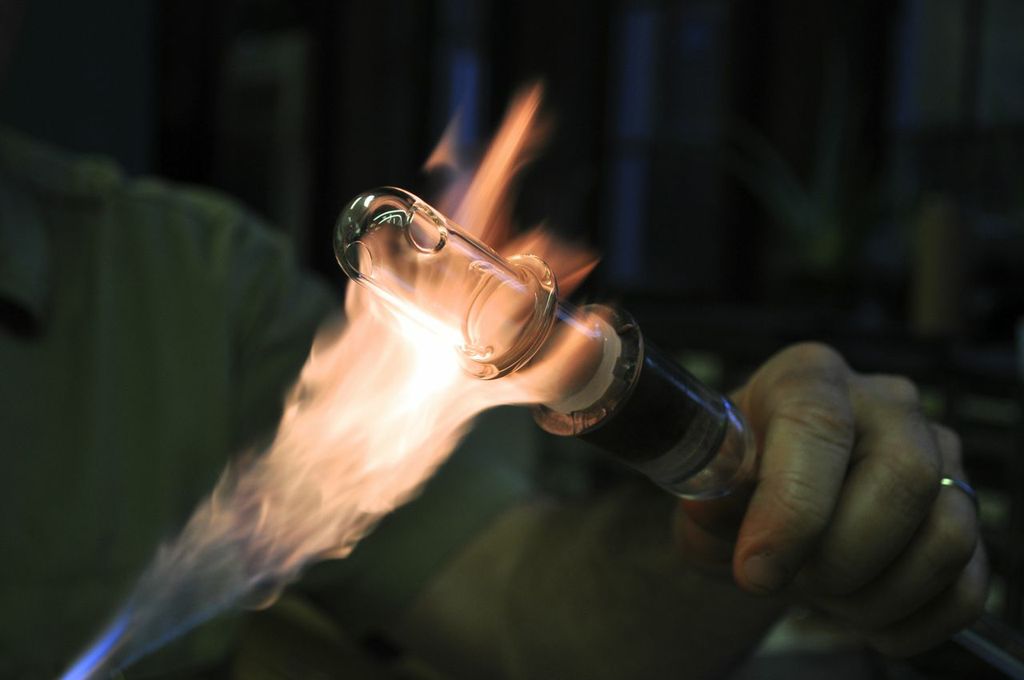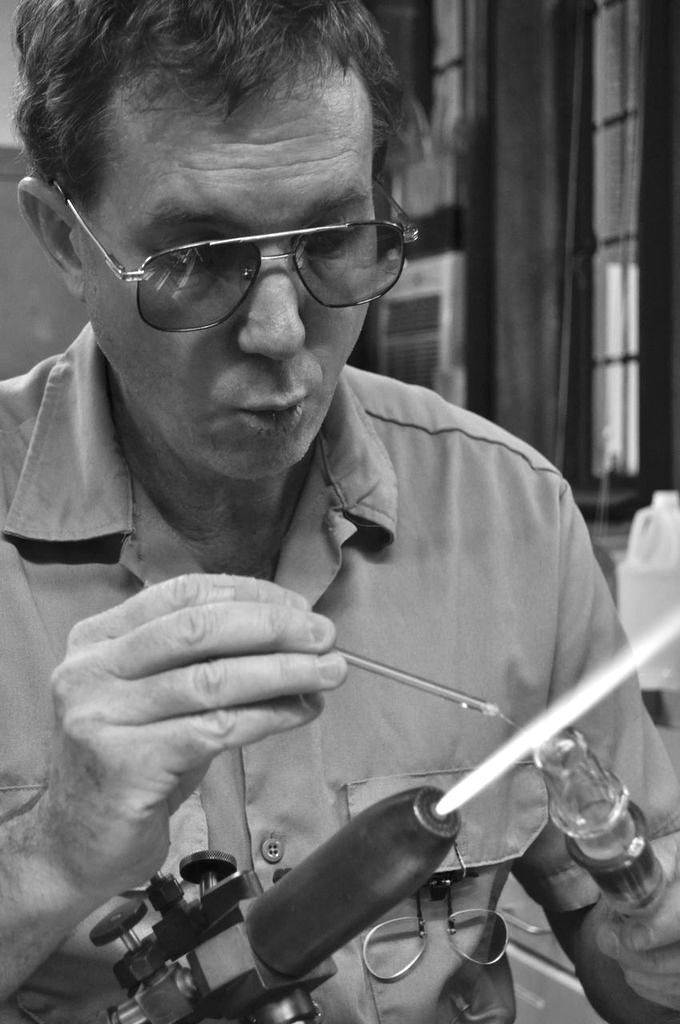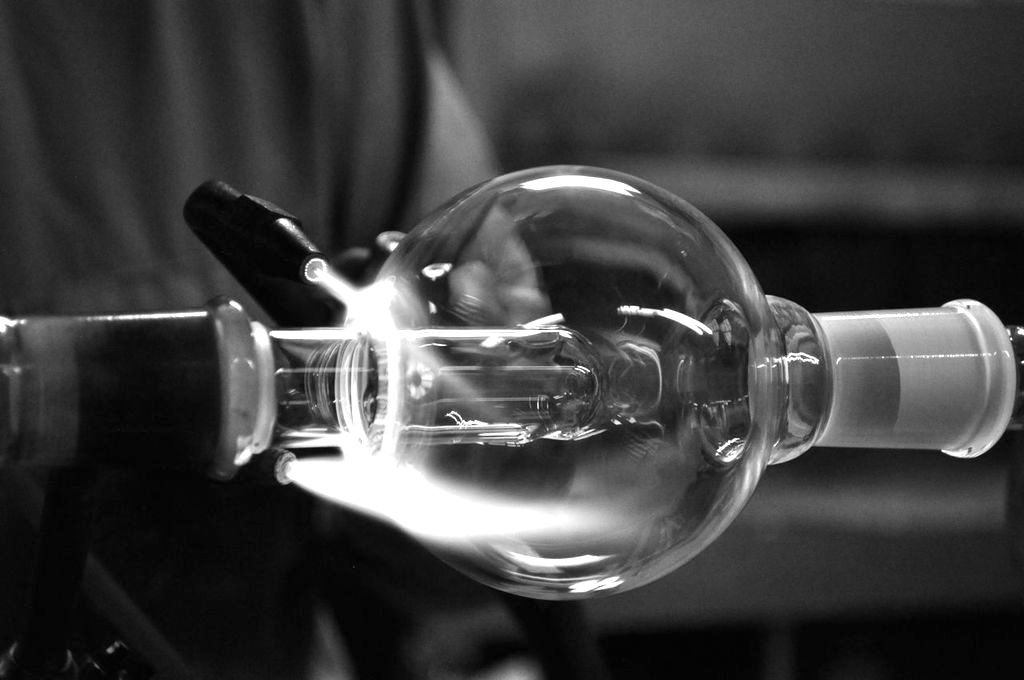
Four thin blue flames lick the underbelly of a glass flask as Daryl Smith steadies his blowtorch. With sweat dripping from his forehead, he directs the heat at one of three stumpy tubes attached to the spherical flask. The glass glows white-hot and starts to melt. Just as the tube begins to droop, Smith snatches it away with a pair of tweezers. The tube stretches until all that connects it to the flask is a long, thin thread. When the thread breaks, a spark of light appears as the chemical bonds in the glass split apart. The glass closes around the quarter-sized hole where the tube once was. During this minute-long part of the process, Smith has been holding a hose between his teeth that connects his mouth to the sphere. He breathes a puff of air into the sphere, and the hole reappears, leaving space for Smith to push the tube in again. He works without talking; the only noise in the studio comes from the jazz playing on a radio in the background.
A soft-spoken man with short brown hair, Smith is Yale’s scientific glassblower. He spends his days building and repairing glass laboratory equipment in a cramped room filled with a mechanical lathe, gas canisters, torches of different shapes and sizes, and boxes of glass pipes, stoppers, and joints. Today’s job comes at the request of Timothy Newhouse, a chemistry professor who inherited the flask, along with other old glassware, from another faculty member. He uses the flask to conduct chemical reactions isolated from the atmosphere. But he needed the protruding pipes replaced so that they were the same shape as and could plug into his other glass equipment.
Smith uses the lathe to rotate the sphere, bathing it uniformly in a blue flame from another torch, to prevent it from cracking as it cools. The final step is to place the piece in a special oven that gradually heats and then cools the glass to strengthen it. After four hours, it will be ready for use in Newhouse’s lab.

Smith has been a glassblower for nearly twenty years. He grew up in Lancaster, Pennsylvania, a few hours away from southern New Jersey, the heart of the glassblowing industry. But he had never considered a career in glassblowing until after college. He was a year out of Texas A&M University when he came across an article in his local newspaper titled, “Glass Blowing: A Job With a Future.” It was 1985, and his job at the time in fisheries science had encouraged him to skew the data in favor of his employer, and Smith recalls thinking, “This is not science.” The article presented a lucrative alternative—and the chance to work with fire. When Smith moved to New York for his wife’s work two weeks later, he brought the clip with him.
Neither Smith nor his wife found success in New York. She didn’t get the job she had wanted; Smith started working for a furniture manufacturing company, where he was passed over for a promotion. His thoughts kept straying back to the article. It had promised a starting salary of around thirty thousand dollars, the equivalent of over sixty thousand dollars today. And North America’s only scientific glassblowing academic program, at New Jersey’s Salem Community College (SCC), happened to be within commuting distance of his in-laws in Pennsylvania.
But before applying to the program, Smith wanted to learn more about what scientific glassblowers actually did. So he talked with his father, a plant manager at Radio Corporation of America, and his brother, a graduate student at Rutgers, who both worked with scientific glassblowers. They told him that glass tradesmen are crucial to the maintenance of industry and research. “It sounded like something interesting to do because it does involve some scientific training, and it does involve working with your hands,” Smith said. “I’ve always enjoyed that. So I gave it a shot.” He enrolled in SCC’s program in January of 1986.
The school still boasts the only academic program for scientific glassblowing in the United States. South Jersey was the birthplace of the glassblowing industry in colonial times. Located at the confluence of major shipping lanes, it’s where glassblowing grew up, says Dennis Briening, current chair of scientific glass technology at the community college. The program currently accepts forty-four students each year, who go on to work at institutions such as the National Institute of Standards and Technology and GE Global Research.
During his first few weeks at the college, Smith practiced making round bottoms on glass tubes and attaching tubes to each other at right angles. The work was, in Smith’s words, “immensely boring,” but he didn’t give up. To learn more, he found a job at Atmar Glass, a small, family-owned glass shop halfway between Salem Community College and Lancaster, and worked part time for the rest of the semester. During the summer of 1986, he began working full time.
As the summer drew to a close, Smith found out that his wife was pregnant. In order to keep their health insurance, he needed to work full time, Smith said, “That was like, bust-ass time!” He spent sixty hours a week—twenty at school and forty at his job—blowing glass to support his growing family. He left the program after completing his second semester so that he could focus more on his job, so he graduated with a certificate as opposed to a degree. By that time, he was already building pieces for Atmar’s regular catalogue, such as boiling flasks, addition funnels, and drying apparatuses. His daughter Mallory was born in 1987, and her brother Preston followed two years later.
Smith often moved for work at the beginning of his career, but he set up a miniature glass studio wherever he lived. One of his houses had an adjoining gray, two-story barn about the size of a one-car garage. He set up a torch on the second floor and worked on repairs during nights and weekends. “It’s shaking in the wind,” Mallory said, recalling one day from her childhood. “But Dad’s up there with the radio on, blowing glass.”
Mallory was six or seven years old when she first learned how to use a glassblowing torch herself. Her father guided her hands for the first hour or so, and then stepped back, watching at a safe distance. She made marbles, pendants, and Christmas ornaments. “It was a cool experience to have him say, ‘You are smart enough and trustworthy enough that you can handle this,’” Mallory said. Still, working with a flame frightened her. Making larger pieces of glass required big flames. “When you’re knee-high with a grasshopper, you’re scared of it,” she said. Her younger brother was often there, right beside her. He learned to blow glass from his father as well.
Smith spent the next few years working for small glass companies on the east coast before he landed a job with Kontes Glass, the largest glass manufacturer in the United States at the time. At Kontes, Smith pushed his craft beyond standard scientific glassware and began making more challenging or extravagant creations. He made yard-long test tubes with diameters as wide as your wrists. He was told that they were horse bloodletting tubes. “Oh my God, those things are huge!” Smith says in recollection. “Poor horse!” To this day, he doesn’t know who placed the order or why. “I kind of didn’t want to find out.” Smith made about two dozen. Each took twenty minutes.
After five years at Kontes, Smith heard about an opportunity too good to pass up. Word was spreading that Joe Luisi, the glassblowing instructor at Salem Community College, was retiring. “It was the job,” Smith said. His application was accepted, and he started teaching in the fall of 2000.
While Smith was an instructor, the college got rid of the one-year certificate program, keeping only the two-year degree. They determined that anyone who had completed the one-year certificate program and attained significant experience could receive the degree. “So I eventually got my associate of applied science while I was an instructor,” Smith said.
Smith enjoyed his job, but started to regret that he spent most of his time teaching as opposed to glassblowing: “I kind of missed building things—the gratification you get from making the apparatus,” he said. After five years of teaching, he took a position at Yale that would allow him to both teach and blow glass. Smith fixes broken equipment and helps researchers with specialty pieces, in addition to teaching a workshop on the basics of scientific glassblowing.
His class is always oversubscribed. It is listed as a graduate-level chemistry laboratory class but is open to all Yale students. This year, all of the participants happen to be graduate students in the chemistry department, but in past years workshop has been entirely undergraduates. The semester follows the course of his daughter Mallory’s lessons: first they make marbles, then Christmas ornaments, before moving on to more advanced concepts.
Students also learn techniques that they can apply in their research. Louise Guard, a fourth-year chemistry graduate student who took Smith’s class last fall, learned how to seal samples of chemicals in glass chambers under vacuum to send out from the lab for outside analysis. “It’s especially helpful if he’s on holiday and you want to send some compounds out.”
Other skills take more time to master. During class on a Tuesday in early October, fifth-year graduate student Sahr Kahn struggled to create a straight seal, which involves smoothly fusing two glass tubes together, end-to-end. Khan bemoaned her work—the glass had wrinkled near the attachment, where it should have been even. “You’re not going to master it in this class,” Smith reassured her, “It takes years.” He had taken four or five years to become proficient at the technique. “What?” Khan whipped around, a mangled piece of glass tubing grasped in hand. “Okay, good!”

While Smith enjoys teaching, he came to Yale so that he would be able to get back behind the torch. Often, his work simplifies otherwise arduous processes. Guard walks around her laboratory, pointing at large apparatuses of connected glass tubes and pipes sitting behind fume hoods. “Without those, we couldn’t do any of our chemistry,” she says. These are Schlenk lines, which Smith builds for the lab. They have eight of these set-ups, which allow chemists to conduct reactions without air getting in the way. Otherwise, they would have to conduct their experiments in a glovebox, which would require them to use unwieldy rubber gloves to manipulate their samples.
Some of Smith’s work is less routine. The strangest request he ever received came from Patricia Brennan, then a postdoc in the Department of Ecology and Evolutionary Biology at Yale. Brennan, a graduate student, and renowned ornithology professor Richard Prum, were studying the mechanics of the duck penis. In order to observe it in action, they needed a transparent alternative to a female duck’s genitalia.
Silicone models were life-like, but too weak. “When we tested them with the males, the males actually broke through every single one,” Brennan said. “The conclusion is: they have an explosive eversion.”
While a noteworthy observation, it also meant that Brennan and her team needed a different model. Brennan and her team approached Smith to request a glass duck vagina, which would be stronger but still transparent. Smith wasn’t as surprised as Brennan and her team thought he would be. He had made strange equipment before while working for Kontes Glass, including glass condom molds. And the glass vagina didn’t require any specialty techniques. “It was just bending,” Smith said. Brennan asked for a few different models: one was a straight tube; two more were spirals with three twists each; a fourth was short and squat, bent like an elbow. They didn’t exactly look like vaginas, Brennan concedes, but the geometry and shape were life-like enough for her purposes.
He is happy with his work, but Smith hopes to push the boundaries of glassblowing—maybe even beyond Earth’s atmosphere: he tells me he wants to be the first glassblower in space. With space technology advancing, he anticipates a need for an on-site glassblower, perhaps at a space station. “I hope they hurry up,” Smith said. “Because I’m getting older.”
Glassblowing in space could be a whole different art form. So much of the skill associated with glassblowing is knowing how to turn pieces of hot glass, which would normally flow downward due to gravity, in order to offset gravity’s effects. “It’s so ingrained and so a necessary part of glassblowing,” Smith said. “To actually be in a non-gravity situation, and to see what it would be like and what you could do with it? Just wild. Mind-blowing.”
Until then, Smith will have to content himself with blowing glass on Earth, a life he enjoys. “It’s like his natural habitat,” Mallory said. “Seeing my dad there, watching football on Sundays, cooking in the kitchen, or blowing glass—he just owns the situation and looks completely in his element.” It’s the same at Yale, whether he’s making a round bottom on a glass tube using a hand torch or fusing a piece of tubing onto a spherical flask. His hands move by instinct, the radio always playing in the background, his concentration never wavering from the glass.

